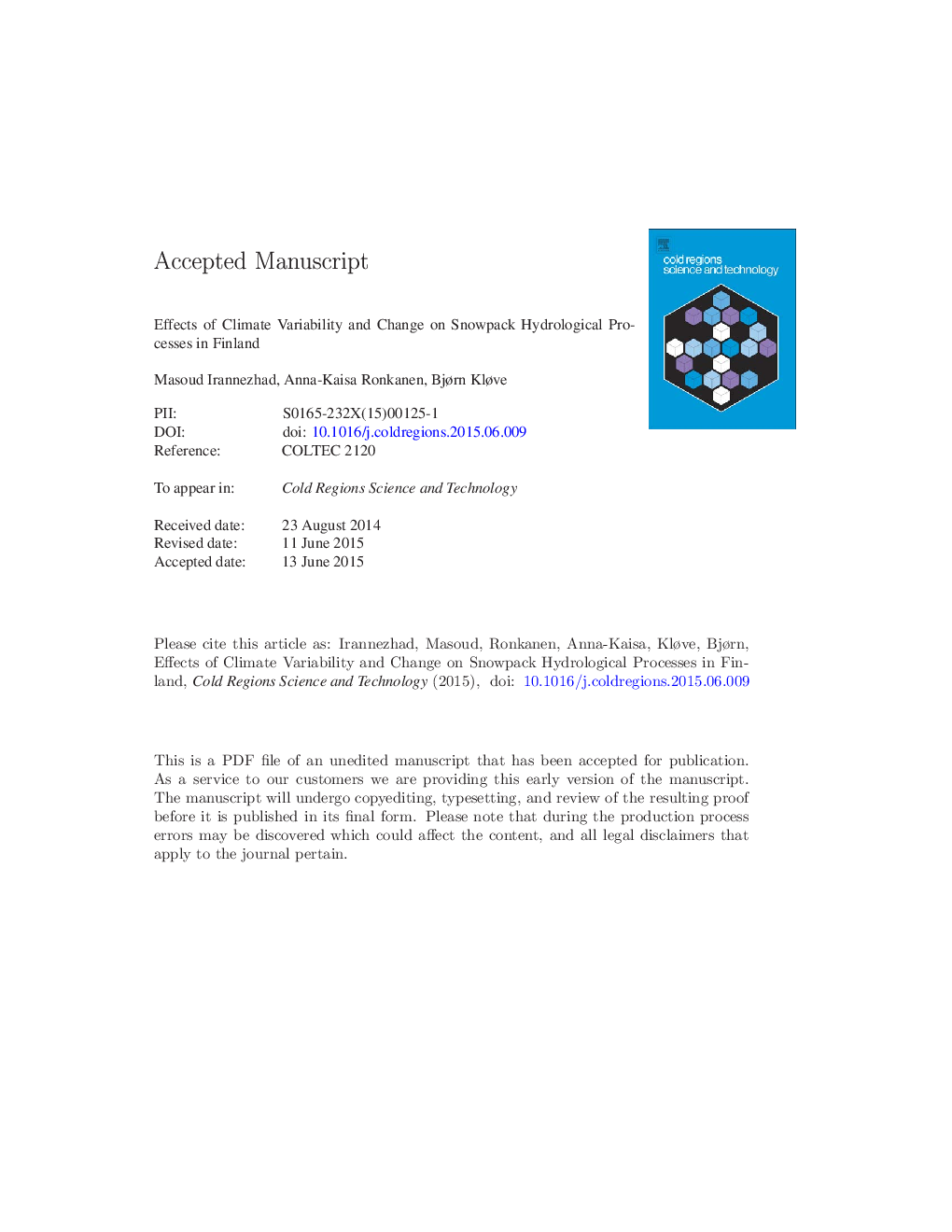| Article ID | Journal | Published Year | Pages | File Type |
|---|---|---|---|---|
| 6426769 | Cold Regions Science and Technology | 2015 | 49 Pages |
Abstract
This study evaluated the effects of climate variability and change on snowpack hydrological processes (SHPs) in terms of liquid water refreezing, water storage as snow water equivalent (SWE) and outflow as total liquid water leaving the snowpack induced by snowmelt flux (melt water releasing from the snowpack after its maximum liquid water retention capacity is reached) and/or rainfall in Finland during the past 100 years. Long-term (> 100 years) daily precipitation and temperature records from three meteorological stations (Sodankylä in northern, Kajaani in central and Kaisaniemi in southern Finland) were used in an empirical snowmelt temperature-index model to simulate different SHPs. The Mann-Kendall non-parametric test was used to detect statistically significant (p < 0.05) trends, the sequential t-test analysis of regime shifts (STARS) to determine cold-mild and wet-dry climate modes, Pearson's coefficient (r) to measure temperature-precipitation and SWE correlations, and Spearman's rank correlation (rho) to identify linkages of these variables to well-known atmospheric circulation patterns (ACPs) over the Northern Hemisphere (e.g. the Arctic Oscillation). Observed mean annual temperature significantly warmed, by a rate of 0.01 °C yearâ 1, at both Kaisaniemi during 1845-2011 and Sodankylä during 1908-2011, which was also associated with a shift from cold to mild climate in 1930 at Kaisaniemi and in 1988 at Sodankylä. However, mean annual temperature showed no clear trend at Kajaani, which was confirmed by the existence of periodicities in cold-mild climatic modes. Conversely, observed total annual precipitation decreased by 0.8 mm yearâ 1 (p < 0.05) only at Kajaani during 1903-2008, which was in accordance with the climate shift from wet to dry mode in 1939. The simulated peak annual SWE significantly decreased in the range 0.57-1.47 mm yearâ 1 at all three stations studied during the 20th century, with the highest rate at Sodankylä. Comparisons of simulated 1-day to 10-day peak outflow indicated that snowmelt flux influenced simulated peak snowpack outflow much more than rainfall. Hence, the magnitude of simulated annual 1- and 10-day peak outflows decreased by 0.055 ± 0.01 and 0.45 ± 0.25 mm yearâ 1 (p < 0.05), respectively, in Finland during the last century. Moreover, simulated annual 1-day peak outflow timing significantly shifted to 12-28 days earlier, while simulated annual 10-day peak outflow timing shifted to 8-40 days earlier (p < 0.05). These results indicate that the snow resource in Finland has significantly declined during the past 100 years under climate variability and change, partly controlled by the Arctic Oscillation, East Atlantic/West Russia, and East Atlantic patterns across the country.
Related Topics
Physical Sciences and Engineering
Earth and Planetary Sciences
Earth and Planetary Sciences (General)
Authors
Masoud Irannezhad, Anna-Kaisa Ronkanen, Bjørn Kløve,
